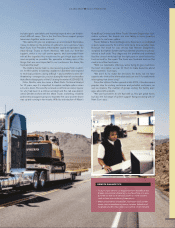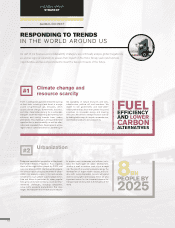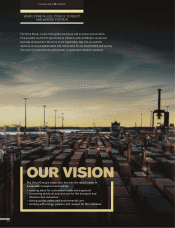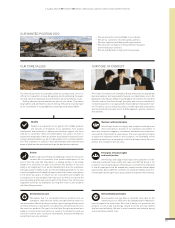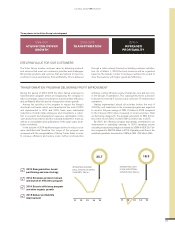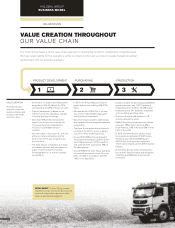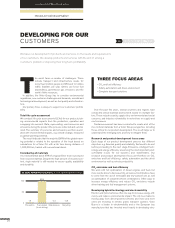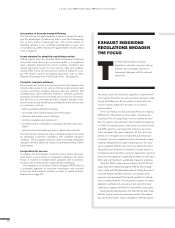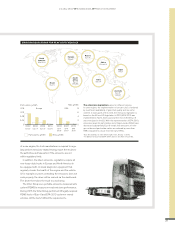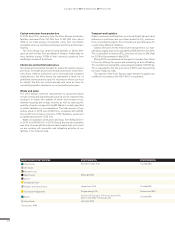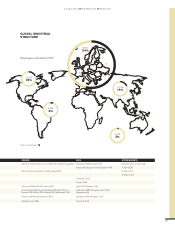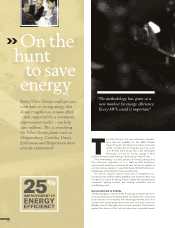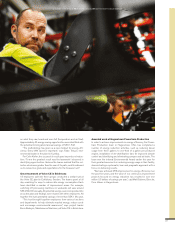Volvo 2015 Annual Report Download - page 29
Download and view the complete annual report
Please find page 29 of the 2015 Volvo annual report below. You can navigate through the pages in the report by either clicking on the pages listed below, or by using the keyword search tool below to find specific information within the annual report.
A GLOBAL GROUP BUSINESS MODEL PRODUCT DEVELOPMENT
tric city buses the last couple of years. In 2012, Volvo Buses took
the decision to only offer complete, low-floor city buses as hybrids
on the European market. Volvo Buses has a product range to
meet all public transport needs by offering hybrids, electric
hybrids (plug in hybrids) and fully electric buses.
On the truck side we believe that, in the long run, a dynamic
supply of electricity from the road could power long-haul trucks.
We are currently developing practical knowledge through our
participation in Electric Road Systems concept studies.
The Volvo Group has also successfully been testing electro-
mobility technologies and road testing fully electric trucks with
European customers for several years. Read more about our
solutions on page 60.
Alternative and renewable fuels
Following years of study and prototype truck trials running on
different fuels, the Volvo Group recognizes that there is no single
solution to meet all needs, see graph Renewable fuels below.
Webelieve conventional diesel fuel, with increasing renewable or
synthetic content, will remain the dominant fuel for all types of
commercial transport for many years.
The Volvo Group position on alternative fuels supports our
strategic objective of efficiency by prioritizing our research and
development to the following applications:
• Long distance: liquid methane and Dimethylether (DME) are
our main alternatives. Dynamic electric charging is an addi-
tional long term alternative.
• Medium distance: compressed methane and DME are our main
alternatives. Dynamic electric charging is an additional long term
alternative.
• Urban: electricity and compressed methane.
World leader in DME
The Volvo Group is the world leader in pioneering DME as an
alternative fuel and field testing continued during 2015 for both
Mack Trucks and Volvo Trucks. In the US, the production of DME
through a process using food waste, was certified by the author-
ities. DME produced from food waste reduces CO2 by 68% com-
pared to conventional diesel fuel. Volvo Group truly believes that
DME holds great promise for the future. The main interest in DME,
as a fuel, lies in the environmental benefits and in the simplicity of
DIMETHYLETHER (DME)
• Can be produced from any biomass source
• Can reduce CO2 emissions up to 95% as BioDME
compared to conventional diesel fuel
• Handled as liquid at 5 bars pressure
• Ultra low exhaust emissions without advanced
aftertreatment
• Relatively simple vehicle technology
• 50% of conventional diesel energy density
• Less noise
Minimized climate impact
Energy efficiency
Efficiency of land use
Fuel potential
Vehicle adjustment
Fuel costs
Fuel infrastructure
Biodiesel
Synthetic diesel
DME (Dimethylether)
Methanol
Ethanol
Biogas
Biogas + Biodiesel
Electricity
HVO (Hydrotreated
vegetable oil)
Hydrogen + Biogas
Optimal Less preferable
RENEWABLE FUELS
the technology as well as the potential for low cost throughout the
value chain. In addition, DME does not create soot when com-
busted and therefore ultralow emissions can be reached without
the need for advanced exhaust aftertreatment.
The Volvo Group will continue developing engines that can
operate on DME as a fuel for commercial vehicles with an initial
focus on highway applications. In the future DME could be used in
most applications.
Safety, automation and driver environment
Safety is about reducing the risk of accidents and mitigating the
consequences of any incidents that occur. The Volvo founders
stated that “safety is and must be the basic principle in all design
work” and our safety ambition is zero accidents with Volvo Group
products. Therefore, safety is an integral part of product develop-
ment. Our aim is to improve product and traffic safety as well as
the work environment for drivers and operators of vehicles and
machinery. Safety can also be improved with the help of auto-
mization where the main benefits are productivity and energy
efficiency.
Safer product and services by research and robots
In Scandinavia, the Volvo Group’s in-house Accident Research
Team has looked at heavy truck accidents for over 40 years. Com-
bining accident data analysis with the Group’s own research and
test programs gives us solid insights into the causes of accidents
and injuries. This work provides important input into our future
product plans, advanced engineering and research. It shapes our
future solutions.
Advanced safety systems require advanced test methods and
therefore Volvo Trucks is now testing advanced safety systems
with the help of robot-steered trucks. Using robots instead of
human drivers results in better precision and repeatability.
27


